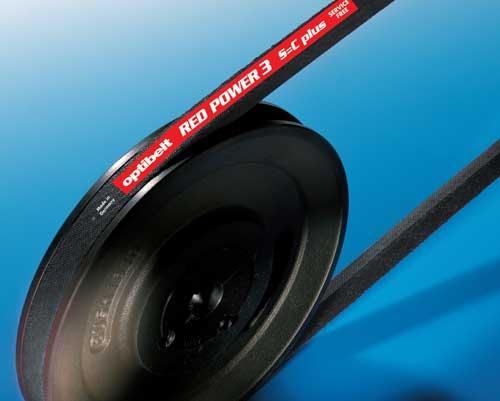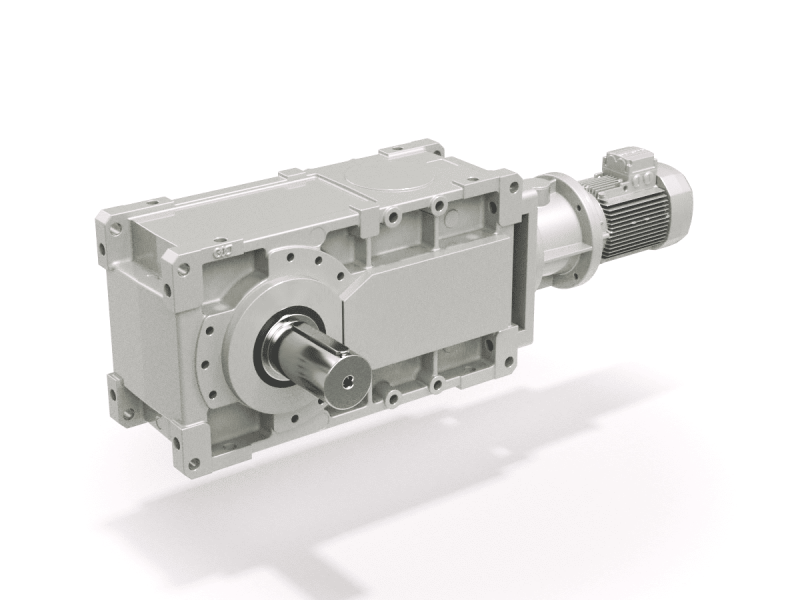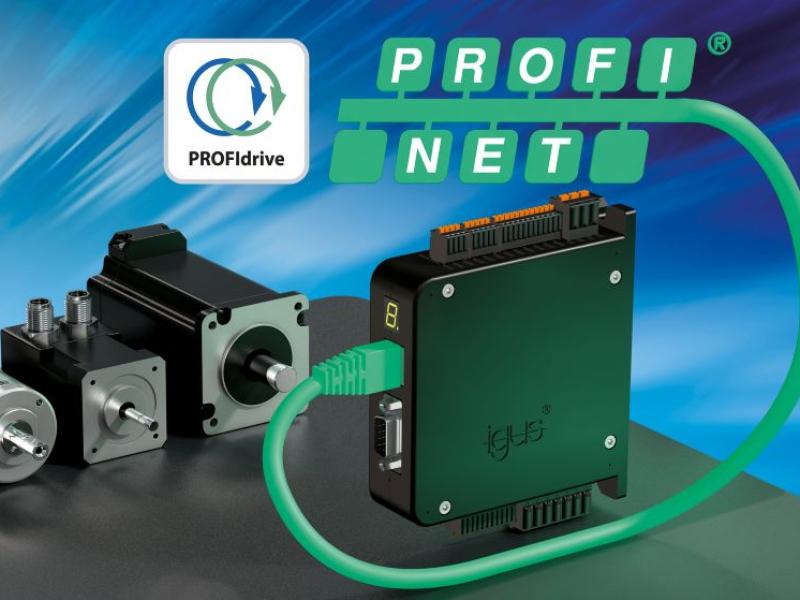A transmission belt that doesn’t need re-tensioning – the German-manufactured Optibelt Red Power V-belt makes this dream come true. Editor Stefan Richter talked to the sole NZ Optibelt agent about the features and advantages of this maintenance-free belt which is being released in its third generation.
According to the German manufacturer Optibelt, insufficient belt tension is one of the main reasons, along with misalignment, for premature transmission belt failure. V-belts rely on tension to transmit power by creating friction on the grooves of the pulley. Too little tension and the belt loses its power transmission capability, starts to slip and quickly wears out. If the tension is too high the belt suffers from excessive stretch plus putting an additional load on bearings, couplings and shafts. “Optibelt estimate that over 90 percent of premature belt failures are caused by installation issues; usually the belts are being tensioned incorrectly,” says Neil Baudinet, Director of Tranz Corporation Ltd. “Most fitters tend to apply gut feeling when it comes to tensioning belts. We have a ‘demonstration rig’, consisting of two small twin-groove SPA pulleys and belts mounted on a frame. If you took it to a workshop with a dozen fitters, and you asked them to tension the belts as they normally would, probably nine out of the 12 fitters would apply an insufficient tension. That’s clearly an issue; fitters generally don’t use tools to accurately measure belt tension. SPZ-profile belts with a top width of 9.7mm will require considerably different tension figures to SPC-profile belts that have a 22mm top width. Very often the recommended re-tensioning after the initial run-in period doesn’t take place either, resulting in poor belt life, wasted energy and excessive downtime.”
Tranz Corporation Ltd pride themselves on being a specialist power transmission and automation company. Besides importing and stocking well-known brands of mainly European origin, such as Lenze and Vogel gearboxes, they are also Optibelt’s sole New Zealand agent. Optibelt is a privately-owned German company specialising in manufacturing transmission belts and are now celebrating their 140th anniversary. “A considerable amount of research and development goes into their products, for example the Red Rower wedge belt, which still remains a unique product,” explains Neil. “With this top-quality product we target the industrial market, working mainly with the primary industries. Many of these companies value reliability and performance. They recognise that if they pay a little more for a premium product they not only get their investment back but actually add value to their business.” The director admits that selling products like the German V-belt sometimes takes some convincing. “It’s a higher-cost product, because of the R&D, the superior quality of the materials used, the sophisticated production processes and stringent quality assurance standards that are in place. However, the companies that utilise Red Power belts appreciate the advantages and they enjoy the resulting superior performance.”
To address the problem of ongoing maintenance and shutdown costs associated with regular re-tensioning, Optibelt introduced the first generation of Red Power belts in the late 1990’s and after further refinement, the second generation in 2003. “The third generation, the Red Power 3, will be available progressively during 2012 and offers one of the highest power transmission capabilities in the industry. All three belt generations are maintenance-free; you fit them once, using the correct set-up procedure, and then you can forget them. “You don’t need to go back to re-tension them for their entire service life,” says Neil. “This is what is meant by maintenance-free.”
A typical V-belt consists of several load-carrying tension cords which are embedded in a transverse fibre compound and covered with an abrasion-resistant cover fabric. “When a standard V-belt is fitted and runs for the first time, it heats up and the tension cord stretches, making it necessary to re-tension it after the running-in period. If re-tensioning does not occur, the belt will continue to lose tension to a point where the efficiency of the drive is reduced,” explains Neil. “Optibelt have specifically designed and patented the Red Power polyester tension cord so that it only expands minimally during the settling-in period.” Once a set temperature is reached, the tension cord locks and the belts retain their tension for the rest of their service life. Optibelt design their belts to have a service life of 25,000 hours. Although this service life is under laboratory conditions, there are many examples of Red Power belts operating in arduous industrial environments achieving close to this high service life. To enjoy these benefits, engineering staff need to follow some simple guidelines regarding alignment of pulleys and accurately measuring belt tension. To assist with this important process, Optibelt produce a range of easy to use and competitively priced service tools. “The initial loss of tension is a normal part of the running-in process. We provide the fitter with the exact initial tension figure that is required, so that he can measure it. There is no guesswork involved.”
With all Optibelt V-belts over 1.2 metres long, belt matching when using multiple belts on a drive is a practice of the past. The ISO standard used by most other manufacturers allows for lengths variations of ±1 percent. While this may sound like a small amount, such a tolerance on a 5000mm belt would allow for belts to be produced as short as 4950mm or as long as 5050mm, giving a total length variation of 100mm. To get around this problem, the industry norm has been to “match” belts of a similar length using matching codes on the belts.
By contrast, Optibelt has an in-house standard for belts up to 5000mm length of ±2mm. This is achieved on a high volume production basis due to the unique “rotary vulcanising” process that cures belts while under tension. Any Optibelt product that has the marking “S=C Plus” (this includes all generations of Red Power) comply with this standard. A set of “S= C Plus” belts are in effect “factory matched” and the load will be evenly carried by all belts on a multi-belt drive. This will lead to longer service life and drive efficiency.
“Compared to an Optibelt standard type SK wedge V-belt, the Red Power II belts display a dramatically improved performance; the Red Power II provides up to 42 percent more power transmission capability, and the Red Power 3 up to 50 per cent,” says Neil. “This higher performance means that in some multiple belt drive installations a lesser number of belts can be used. Such an example would be going from eight standard wedge belts to perhaps five or six Red Power belts. This means narrower, lighter and less expensive pulleys resulting in less overhung loads on bearings and shafts”.
Optibelt market their Red Power belts with a drive efficiency of up to 97 percent. This is not only the efficiency on start-up but one that is ongoing due the ability of the belt to retain its tension. In order to achieve this outstanding result, best engineering practices should be followed. Improper belt tensioning, worn pulley grooves, angular and axial misalignment not only reduce the overall efficiency, but also compromise the belt’s service life. “There are a lot of variables when it comes to efficiency,” says Neil, “but care taken during the installation will be rewarded with a longer service life and higher drive efficiencies with lower operating costs.”
To assist in the installation process, Optibelt produce a range of service tools that includes simple devices accompanied by a reference chart for belt tension to more sophisticated hand-held electronic devices that are extremely accurate. Profile gauges are the easiest way to determine wear in pulley grooves and a compact laser tool with calibrated marker posts will accurately measure axial or angular misalignment.
With the help of Optibelt’s CAP drive calculation program it is quite simple to design functioning and optimally tuned drive systems. “Our customers advise us the important parameters such as motor speed, shaft diameters, engine power, required output speed etc. The software provides a recommendation, stating details such as number and lengths of belts, centre distance, diameters of pulleys, taper-lock bush sizes and shaft loads. There is also a recommendation for the correct belt tension and shaft loads to enable the bearing ratings to be checked,” explains Neil. The sophisticated software is also of assistance when it comes to troubleshooting faults on existing drive systems. “Equipped with this software and the service tools previously mentioned, our experienced and well-trained staff can go onto an industrial site, identify the cause of a problem and make suggestions for improvement.”
Sometimes, especially with larger industrial sites, you can find a whole raft of different belts in use. “When there is a problem or pulleys are worn and need replacing, we use this as an opportunity to check and, where appropriate, re-engineer the drive utilising another size of belt that the customer is already using elsewhere within the plant,” says Neil. “That way they can cut down their inventory. In some cases replacing a special diameter or uncommon section pulley than is worn requires a custom build. This could be more expensive than redesigning the whole drive using new pulleys and belts of a more conventional profile. In each case we strive to work with the customer to find a solution that gives us credibility by solving the customer’s problem and adding value to his business.”
There has been a trial at a North Island pulp and paper site in New Zealand to quantify the energy savings achievable with the Red Power II belt. This belt and a competitor product were used to drive a storage tank agitator over a complete cycle of 109 hours. First the competing belt was fitted, the motor energy consumption was monitored and the percentage of full load current being used was graphed. Then the belts were swapped and the Red Power II was assessed under identical conditions. The Optibelt product showed an energy saving in excess of 10 percent.
During another trial the Red Power II and its rival faced off directly. The purpose of this trial was to prove to the customer that the Red Power belt would not require further tensioning. This happened at a board mill site in New Zealand, where a set of each belt type was installed to the drives of slash deck saws. After being tensioned and aligned the drives operated continuously (for approximately 920 hours). Upon shutdown, the tension of both belt sets was measured. The Red Power II showed a small loss of tension which is associated with the settling period and this was in line with the figures given by the Optibelt. The competing belt set had a 54.4 percent loss of tension and would have required regular re-tensioning to continue operating efficiently. Because of the continuous operating nature of these saws, belt tensioning cannot be carried out at regular intervals and Red Power was designed to provide the optimal solution to overcome this problem.
This trial demonstrated that there is a significant ongoing performance and energy efficiency advantages offered by Red Power that are evident within the first fiven percent of its service life.
Email: neilb@tranzcorp.co.nz






